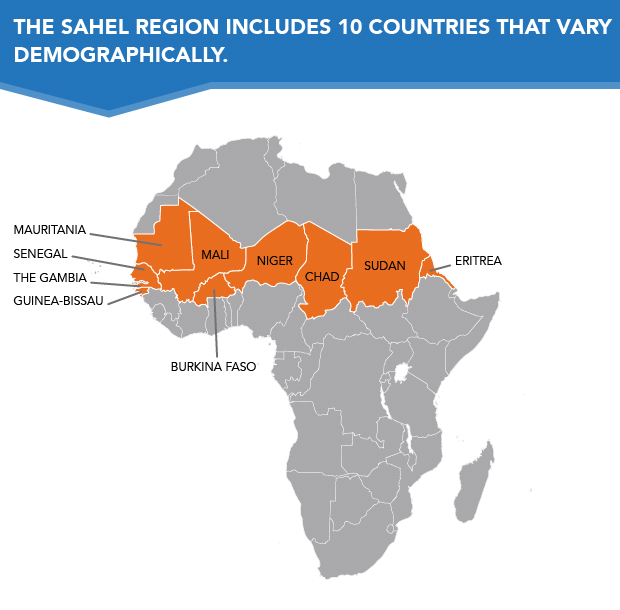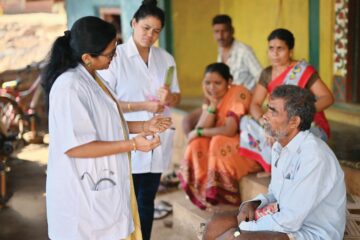
Demographic Challenges of the Sahel
Date
January 14, 2015
(January 2015) This article is a short summary of an essay by John F. May and Jean-Pierre Guengant, “Les défis démographiques des pays sahéliens,” ÉTVDES 4206 (2014): 19-30, which has been used here with kind permission of the French monthly ÉTVDES.
Most regions of the world have experienced gradually declining rates of population growth. However, sub-Saharan Africa’s population is still growing rapidly because the region has not yet embarked on its “demographic transition” from high to low birth and death rates.
The population of sub-Saharan Africa, estimated at 920 million in mid-2014, will more than double in the next 36 years. These projected demographic changes will have tremendous consequences for many issues, from agricultural production to prospects for socioeconomic development, as well as for the political stability of many countries. The Sahel, in particular, will face the most extreme challenges, compounded by the threat of the Al-Qaeda in the Islamic Maghreb.
The Arabic word sahel (“shore”) denotes the transition zone between the Sahara Desert to the north and the savannah plains to the south. It is a semiarid region with an average rainfall between 12 to 20 inches per year. Since the definition of the Sahel is based on climate, it does not abide by strict international borders. Yet, the demographic figures and future population projections only exist at the country level. This article focuses on the 10 countries that make up the Sahel region—Burkina Faso, Chad, Eritrea, The Gambia, Guinea-Bissau, Mali, Mauritania, Niger, Senegal, and Sudan (see map).

These 10 countries span over 7 million square kilometers and have close to 135 million inhabitants.1 Some of the larger countries that contain extensive expanses of desert (Mali and Niger) have low population densities of fewer than 20 people per square kilometer. Other geographically smaller countries that have access to the sea (such as Senegal) have population densities of 50 people or more per square kilometer. Landlocked Burkina Faso has a population density of 65 people per square kilometer (see table). Only The Gambia has more than 150 people per square kilometer.
Key Demographic Indicators of the 10 Countries of the Sahel, 2014
| Country | Population (millions) | Annual Rate of Natural Increase (%) | Population Density (persons per sq. km.) | Total Fertility Rate (average number of children per woman) |
|---|---|---|---|---|
| Burkina Faso | 17.9 | 3.1 | 65 | 5.9 |
| Chad | 13.3 | 3.3 | 10 | 6.6 |
| Eritrea | 6.5 | 2.6 | 56 | 4.7 |
| The Gambia | 1.9 | 3.1 | 169 | 5.6 |
| Guinea-Bissau | 1.7 | 2.5 | 48 | 5.0 |
| Mali | 15.9 | 2.9 | 13 | 6.1 |
| Mauritania | 4.0 | 2.6 | 4 | 4.1 |
| Niger | 18.2 | 3.9 | 14 | 7.6 |
| Senegal | 13.9 | 3.2 | 71 | 5.3 |
| Sudan | 38.8 | 2.5 | 21 | 5.2 |
Note: Sudan does not include South Sudan.
Source: Carl Haub and Toshiko Kaneda, 2014 World Population Data Sheet (Washington, DC: Population Reference Bureau, 2014).
The region’s GDP per capita in purchasing power parity is relatively low, ranging from approximately US$900 to less than US$3,000 per capita, with the only significant income coming from natural resources like oil and minerals.2 The World Bank’s 2015 Doing Business report ranks these nations among the least business-friendly, due in large part to their history of political instability.3 Moreover, the World Bank lists half of the nations of the Sahel as fragile states (low-income countries with weak state capacity).4
Significant population growth appears to be the strongest force driving the region’s potentially turbulent future. With annual demographic growth rates ranging from 2.5 percent to nearly 4 percent, the population will continue to grow beyond the region’s capacity. This growth has occurred because of commendable rapid decreases in infant and child mortality but lagging decreases in fertility. With total fertility rates between 4.1 and 7.6 children per woman on average, the region’s population might increase from almost 135 million today to 330 million by 2050 and close to 670 million in 2100. These estimates follow the United Nations medium assumption for fertility reduction, yielding values that these countries do not show signs of actually being able to meet.
The age structure of the 10 countries of the Sahel will remain predominately young. The number of youth—those younger than 20—will double by 2050. Niger will have the highest youth dependency ratio (ratio of those younger than 20, or dependents, to those ages 20 to 64, or working age) for the next 36 years. Even in 2050, Niger will have 132 people younger than 20 for every 100 people ages 20 to 64. The demographic dividend that could be gained from a larger workforce (when relatively more working adults support relatively fewer dependents) appears to be decades away for the majority of the countries of the Sahel.
Increasing temperatures will also be a factor. Climatologists suggest that the temperature of the Sahel will increase by 3 to 5 degrees Celsius by 2050 and possibly 8 degrees Celsius by 2100.5 Rainfall will decrease and become more erratic. Agricultural production will decrease from anywhere between 13 percent in Burkina Faso to almost 50 percent in Sudan. Other sectors will also face challenges in the next decades: It is unlikely that basic educational and health care infrastructure will be able to meet the rapidly increasing numbers of youth, nor will the formal sector of the economy be able to create enough jobs for upcoming generations.
The region’s challenges are neither simple nor one-dimensional. The obvious question remains of what can be done. Progress in the Sahel can be achieved through five main initiatives:
- Accelerating the demographic transition.
- Strengthening existing infrastructure.
- Building human capital (education and health).
- Improving governance.
- Creating jobs.
First, determined action must be taken to slow rapid population growth. Improving female education has been one of the most significant factors associated with decreased fertility, but educating the majority of girls in the Sahel will take time. Moreover, past focus on birth spacing instead of birth limiting, along with small increases in contraceptive prevalence, have not translated into rapid fertility declines. Populations must also be informed of the benefits of smaller family size, access to contraceptives must be improved, and the legal age of marriage must be raised. These changes will reduce the strain on the existing infrastructure and natural resources, allow for more educational investments in young people, and create the possibility of a demographic dividend in the long run. Increased investments in health care and education can increase both the quality and the range of services provided. Transparent and stable governance is also crucial to regional progress. Finally, both the formal and informal sectors must be tapped to increase employment as well as to improve productivity and efficiency.
These five initiatives should be implemented simultaneously. Too often, governments and their partners work only on one or two at any given time. Indeed, given the formidable demographic challenges of the Sahel, the time for action is now.
References
- Carl Haub and Toshiko Kaneda, 2014 World Population Data Sheet (Washington, DC: Population Reference Bureau, 2014).
- World Bank, “World DataBank: World Development Indicators,” accessed at http://databank.worldbank.org/data/views/variableselection/selectvariables.aspx?source=World-Development-Indicators, on Nov. 24, 2014.
- World Bank, Doing Business 2015: Going Beyond Efficiency, 12th ed., accessed at www.doingbusiness.org/reports/global-reports/doing-business-2015, on Nov. 24, 2014.
- World Bank, “Harmonized List of Fragile Situations FY14,” accessed at http://siteresources.worldbank.org/EXTLICUS/Resources/511777-1269623894864/HarmonizedlistoffragilestatesFY14.pdf, on Nov. 24, 2014.
- Malcolm Potts et al., Crisis in the Sahel: Possible Solutions and the Consequences of Inaction (Berkeley: The OASIS Initiative, 2013).






